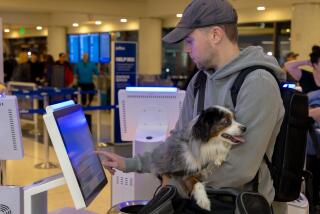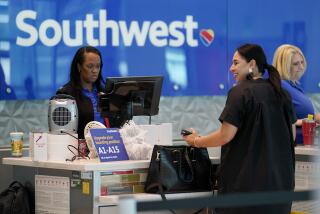Companies Take the Frugal Route
CATHY HALL-ZIENTEK can tell that business has been picking up lately at Moog Inc. As travel manager for the aircraft parts maker, she has been busy booking employee trips.
“We’re sending people where the business is,” she said. Already this year, travel spending at the East Aurora, N.Y.-based company has increased about 10% from a year ago, as more workers hop on flights bound for China, Germany and the 21 other countries where Moog operates.
“It’s not just upper management,” Hall-Zientek said. “It’s everyone.”
And they’re finding plenty of company on the road.
After a couple of difficult years, U.S. companies are starting to loosen the purse strings when it comes to business travel. Nearly half of corporate travel managers said their 2004 budgets had increased, according to a survey by the National Business Travel Assn. released in January.
“Corporations have been hunkered down for quite a while,” said Bill Connors, executive director of the Arlington, Va.-based trade group. But now there’s “a sense that it’s time to get out there, to talk to customers again.”
Terrorism, the economic downturn, war in Iraq and the SARS epidemic all put a crimp in business in recent years, so companies had ample reasons to slash their travel budgets.
That in turn made corporations and their employees savvier customers of travel services. From choosing accommodations at mid-priced hotels to flying on low-fare carriers, business travelers became skilled at paring expenses.
So even as companies start to green-light more travel this year, they will be clinging to their newfound cost-cutting ways. Nearly two out of three still expect workers to stay at mid-range hotels and fly on discount airlines even more than they did in 2003, according to the NBTA survey.
At Avery Dennison Corp., a Pasadena-based global label maker, employees have learned to be more “efficient” travelers, said corporate travel manager Michael Lyons.
“Our people are still traveling,” Lyons said. “They are just doing it more ... wisely.”
“The glamour,” he added, “is long gone.”
To be sure, plenty of business travelers still book stays at luxury hotels and fly first class, but companies are likely to be more discriminating about giving the go-ahead for such trips, said Joe Brancatelli, editor and publisher of www.joesentme.com, an electronic newsletter for business
travelers.
“Sometimes they do need to be in the Beverly Hilton or the Peninsula” in Beverly Hills for the image of success those hotels project, he said. But “other times, the Hilton Garden Inn in El Segundo works just fine.”
The more businesspeople on the road, the better it is for companies such as Carlson Wagonlit Travel, the world’s second-largest travel management company. In anticipation that a business travel recovery is in sight, Minneapolis-based Carlson earlier this month bought a smaller corporate travel competitor for an undisclosed amount.
“A year ago, we were in the tank,” said Carlson President Robin Schleien. But now, “things are pretty stable,” he said, and the company is seeing a 4% increase in corporate travel bookings each month.
At Embassy Suites Hotels, the 174-hotel chain owned by Hilton Hotels Corp., brand manager David Greydanus is “cautiously optimistic” that 2004 will be a better year for business travel. He’s already seen a 2.5% uptick in sales in January and a 5% increase in February.
“After three tough years in our industry, we’re seeing some good, early signs,” said Greydanus, who noted that group travel bookings seem to be increasing.
Embassy Suites, an upscale hotel where suites start at around $150, gets 60% of its bookings from business travelers -- and is working hard to woo more of them.
The company promises that all hotels in the chain will be wired with high-speed Internet access by June.
“It’s an informal, relaxed business hotel which demands a premium price,” Greydanus said. “But it’s a great value for travelers, because you get a suite.”
As demand starts to climb this year, prices are expected to follow. The NBTA forecasts that by 2005, business airfare will increase by 5%, hotel rates by 3%, and corporate car rentals by 2%.
Despite such optimism, many large companies say business travel spending will never return to levels of previous years, as corporations strive to keep travel costs low.
“Let’s not go on a plane if we don’t have to,” was the mantra after Sept. 11, 2001, at Houlihan Lokey Howard & Zukin, a Los Angeles investment bank, according to Co-Chief Executive Scott Beiser.
Although more of his employees have been traveling in recent months, Beiser said the company “certainly considers the costs of travel more than we did five years ago.”
At Moog, travel manager Hall-Zientek said that even though more employees had been traveling this year, the company had been able to keep a lid on expenses by renegotiating contracts for hotel rooms and rental cars at the same rates as in 2003.
Competition among travel suppliers made bargaining easy. “They’ve all been very generous,” she said. “They know corporations are struggling to cut travel costs.”
Moog’s employees also are encouraged to travel on such low-fare carriers as JetBlue or Air Tran whenever possible, and to look for other creative ways to spend less, such as eating at less-expensive restaurants.
Employees know the days of the travel account “gravy train” are over, Hall-Zientek said.
“Everyone is traveling more,” she said, “but they are conscious they need to keep costs down.”
*
(BEGIN TEXT OF INFOBOX)
Road to recovery?
Signs point to an improving business travel climate. These statistics include corporate and unmanaged business transient travel (air, car, hotel) and related travel and entertainment expenses.
U.S. business travel market
(in billions of dollars)
*--* Year Total % Change 2002 $139.50 n/a 2003 $140.90 1% 2004* $146.20 3.8% 2005* $156.30 6.9% 2006* $163.50 4.6%
*--*
*Projected
Sources: PhoCusWright Inc., PhoCusWright/NBTA Technology Trends Survey, American Express, Runzheimer International, Smith Travel Research, Topaz International
More to Read
Sign up for The Wild
We’ll help you find the best places to hike, bike and run, as well as the perfect silent spots for meditation and yoga.
You may occasionally receive promotional content from the Los Angeles Times.






